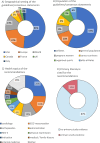Sports Preparticipation Evaluation for Healthy Adults: A Consensus-Based German Guideline
- PMID: 40608238
- PMCID: PMC12460515
- DOI: 10.1007/s40279-025-02230-5
Sports Preparticipation Evaluation for Healthy Adults: A Consensus-Based German Guideline
Abstract
The benefits of physical activity are undisputed. However, adverse events can occur in rare cases, particularly during high-intensity or prolonged exercise. During physical activity, at-risk patients can experience major cardiac events, whereas adverse events affecting the musculoskeletal system are more common but less severe. A sports preparticipation evaluation (PPE) for apparently healthy adults is designed to detect at-risk individuals and prevent potentially fatal events. This guideline for conducting PPEs was developed by consensus among 16 medical societies and sports associations and is based on previously published guidelines and consensus papers. Sports medicine physicians and potential participants were also surveyed to assess the recommendations' content, feasibility, and implementation. On the basis of the 20 recommendations developed and agreed upon by the abovementioned entities, PPE comprises individuals' personal, family, and sports histories, as well as a physical examination. The need for additional examinations (e.g., laboratory parameters, echocardiograms, or stress tests) is determined on the basis of the PPE findings. This approach's feasibility in various regions, including resource-limited settings, and the extent to which it prevents adverse or potentially fatal events, should be examined in future research.
© 2025. The Author(s).
Conflict of interest statement
Declarations. Funding: Open Access funding enabled and organized by Projekt DEAL. The authors have not received a specific grant for this research from any funding agency in the public, commercial or not-for-profit sectors. The guideline-development process was not supported financially; all members of the working groups were volunteers. The IFOM received funding from the lead professional organization (DGSP) for the preparation of the synopsis and the implementation of the surveys, but there was no further financial support. Conflict of interest: Information on the management of potential conflicts of interest is listed in the Supplementary Material (S1). Below, only relevant competing interests are listed: C.J., B.W., A.N., and T.S. are members of the DGSP executive board. C.K. is the head of the DGSP office. A.H., M.C., T.K., K.R., A.N., F.M., H.S., C.R., F.M., K.K., P.P., and A.C. are members of the DGSP scientific board/experts. K.R. is the owner of a software company for metabolic endurance diagnostics (Ergonizer Software e.K., Germany). T.S. received research funding from an ergometer manufacturer (Ergoline GmbH, Germany). All other authors declare that they have no competing interests. Data availability: The data presented in this study are available on reasonable request from the corresponding author. Patient consent for publication: Not applicable. Ethics approval: Not applicable. Author contributions: C.J. conceived the idea for the consensus statement. C.J., A.H., A.N., and B.W. formed the consensus groups. C.J., B.W., A.N., A.H., A.C., C.R., and K.K. led the working groups. K.G. and A.W. ensured compliance with the predefined guideline methodology. All authors were included in the development of the recommendations. They contributed to reviewing and giving feedback on each iteration of the consensus draft. All authors read and approved the final version of the manuscript.
Figures



References
-
- Piepoli MF, Abreu A, Albus C, Ambrosetti M, Brotons C, Catapano AL, et al. Update on cardiovascular prevention in clinical practice: a position paper of the European Association of Preventive Cardiology of the European Society of Cardiology. Eur J Prev Cardiol. 2020;27(2):181–205. 10.1177/2047487319893035. (Epub 20191212). - PubMed
-
- Franklin BA, Eijsvogels TMH, Pandey A, Quindry J, Toth PP. Physical activity, cardiorespiratory fitness, and cardiovascular health: a clinical practice statement of the American Society for Preventive Cardiology part II: physical activity, cardiorespiratory fitness, minimum and goal intensities for exercise training, prescriptive methods, and special patient populations. Am J Prev Cardiol. 2022;12: 100425. 10.1016/j.ajpc.2022.100425. (Epub 20221013). - PMC - PubMed
-
- Maron BJ. The paradox of exercise. N Engl J Med. 2000;343(19):1409–11. 10.1056/nejm200011093431911. - PubMed
Publication types
MeSH terms
LinkOut - more resources
Full Text Sources
Medical

